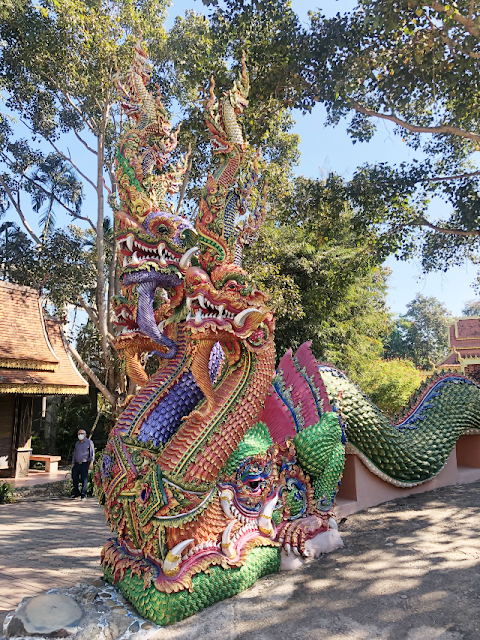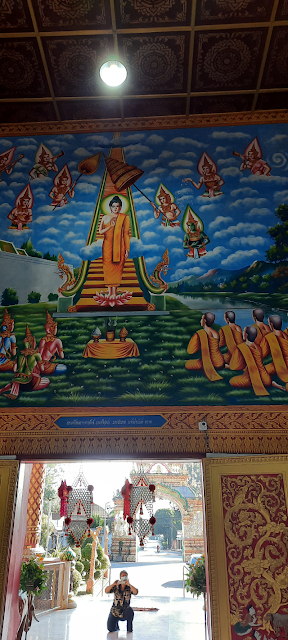Coming down from the stupa at hill top, we skipped the textile museum on our left side and turned straight towards the temple I had been waiting for to see.

view of stupa, viharn
Wat Phrathat Pha-Ngao formerly called Wat Sobkhame was situated on the banks of Khong (Mekong) river. The river overflowed and caused the temple to collapse. The temple patrons decided to move the temple to a small nearby temple.
In February 1976, the temple patrons began to clear the dense forest and came across a cave named "Tham Pha-Ngao" which was shut for a very long time. A half statue of Buddha image which is 20 feet wide was also found when the construction of viharn began.
They intended to repair the ruin and bring it to original status. At night, on 28th February, 1976, Mr. Chanta promma, one of the patrons had a dream in which a black and tall monk told him that before elevating the piece....... 8 monks should perform a religious service......
I could not read further
I have already written about the history of this temple in my earlier post, Wat Phra That Pha Ngao, Amphon Chiang Saen
view of stupa
Buddha image inside an alcove
People make a wish and stick gold foils on it.

Stairs run around the boulder. It is said that if one circumambulates the chedi and prays, the person is cured of all illnesses.
coming down the stairs
a family praying
It is believed that Khun Pa Ping, the 23rd ruler of Yonok Nakhon Kingdom constructed it in BE 494-512 ( 1037-1055 A.D.)
Viharn:
A fairly new cemented three tiered construction is the viharn. I do not know whether this is going to be like this or is going to be painted.
Viharn of Wat Phra That Pha Ngao
body of naga goes all the way to the entrance of viharn
naga head at entranceLeft figure:"Sit Ta Tha cutting hair as the Prince Lord "Buddha" reached the nex of Anoma river. He took off his dresses and articles used as a sovereign. He cut his hair with holy lance and changed to a hermit. The time period is stated to be 29th years of age"
Right figure: "Prince Sit Ta Tha" riding on Kantaka, his horse. Four devotees followed putting their hands under the horse's hoofs and carried to Anoma river."
inside view
During the construction of viharn, people found another Buddha at the base of 20 feet Buddha. After half of the image was revealed, further excavation was stopped and a prayer was performed. The image is called "Luang Pho Pha-Ngao."
The image scene has been kept as such and no changes have been made. Stuccoed bust of Buddha with other pieces found lie on side
The image of Buddha (Luang Pho Pha-Ngao) is in Bhumisparsh mudra, or subduing Mara is in Chiang Saen art which has been influenced by Sukhothai style. The image sits on a large firm brick base. You have to crane your neck to see it properly.
couple taking blessings from monk
All around the viharn, are teak engraved in Lanna style depicting scenes from the life of Buddha.
panel showing Buddha taking seven steps soon after he was bornpanel showing reclining Buddha
Buddha giving his first sermon
standing Buddha
Buddha sitting on a lotus
entrance door carving depicting daily Lanna life of people
 Once outside, on the right are naga stairs which lead to obosuth, Wat Phra That Chom Cham, bell tower. It is half way to the chedi on top.
Once outside, on the right are naga stairs which lead to obosuth, Wat Phra That Chom Cham, bell tower. It is half way to the chedi on top.side of viharn, Buddha in different postures
International Buddhist Tripitaka Hall:
Heading to the side of a beautiful building with multi-colored naga at entrance. In the center of a pond, is the Tripitaka hall.
Information on the board above: "The golden Lanna style teakwood building was built to commemborate the occassion of His Majesty King Bhumibol Adulyadej's 80th birthday anniversary, December 5th 2550 B.e. (2007). His Majesty, the King graciously gave the anmae for the hall on May 9th, 2550 B.e.
The lower part of the building is supported by 80 re-enforced concrete pillars and surrounded by swamp. The first floor and surrounding porches are made of sandstone.
the total construction budget of 19,750,999 Baht came from donations of the Julla Kathin sets of yellow robes offered for the Buddhist Lent between 2548-2552B.e.(2005-2009)
On January 29th, 2549 B.e., the foundation stone for the Tripitaka Hall in the middle of the swamp.
On December 2nd, 2550 B.e, her Royal Highness Princess Maha Chakri Sirindhorn visited Wat Phra That Pha-Ngao to elevated seven tiered parasol on top of Tripitaka hall and to anoint and sprinkle gold and alloy leaves for the molding of the temple's secret Buddha amulets.
On February 15th, 2554B.e,at 09:30. Her Royal Highness on behalf of His Majesty, The King, paid another visit to Wat Phra That Pha-Ngao and graciously presided over the opening ceremony of both the Tripitaka Hall and the Lanna Cultural Exhibition Hall."
Ho trai or Tripitaka hall stands in the middle of a pond.
entrance
Inside the hall are many wooden cabinets which have Tripitaka(Buddhist scriptures).
The beautifully carved cabinets have collection from India, Cambodia, Thailand and Laos.
The outer wall of hall has images of well known temples in Northern Thailand.
the roof of hall
Lanna Cultural Exhibition Hall:
You cannot miss this beautifully three tiered building.
Exhibition hall


multicolored naga

exhibition hall entrance

entrance guarded by mom on either side
Moms are mythological protecting animal which are usually seen at the entrance of a temple in Thailand.

entrance to museum

King Mengrai, first King of Lanna Kingdom

Pictures taken of personalities who visited the temple

roof of museum

figure on the door

side view
It was a wonderful experience for us. Had never seen a temple like this. Though, a little distance from Chiang Rai, it a must visit, if time permits.
















































































